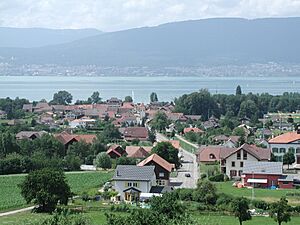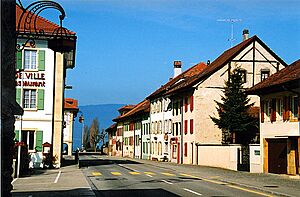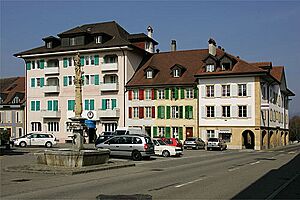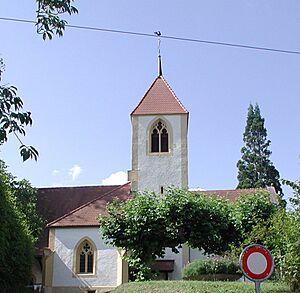Cudrefin facts for kids
Quick facts for kids
Cudrefin
|
||
|---|---|---|
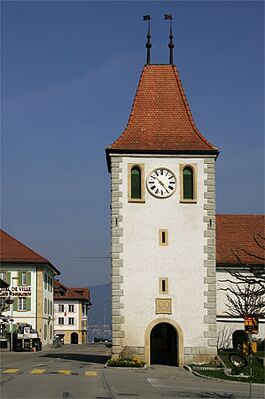
Cudrefin village clock tower
|
||
|
||
| Country | Switzerland | |
| Canton | Vaud | |
| District | Broye-Vully | |
| Area | ||
| • Total | 15.5 km2 (6.0 sq mi) | |
| Elevation | 434 m (1,424 ft) | |
| Population
(Dec 2020 )
|
||
| • Total | 1,780 | |
| • Density | 114.8/km2 (297.4/sq mi) | |
| Demonym(s) | Les Cudrefinois | |
| Postal code |
1588
|
|
| Surrounded by | Vallamand, Mur, Montmagny, Joressens | |
Cudrefin is a small town, also called a municipality, in Switzerland. It's located in the canton of Vaud, within the Broye-Vully area. This charming place sits right next to Lake Neuchâtel, offering beautiful views.
Contents
History of Cudrefin
Cudrefin has a long history. It was first mentioned in official writings way back in the year 999. At that time, it was known by the name Curtefin.
In 2002, another nearby village called Champmartin joined with Cudrefin. They decided to keep the name Cudrefin for the combined area. The municipality now includes the main village of Cudrefin, a small hamlet called Montet, and the village of Champmartin.
Geography and Nature
Cudrefin covers an area of about 15.82 square kilometers (about 6.1 square miles). A large part of this land, over 60%, is used for farming. This means there are many fields for crops and pastures for animals.
About 22% of the area is covered by forests, which are full of trees. A smaller part, about 8%, has buildings and roads. There are also rivers and lakes, making up about 0.5% of the land. The rest of the land is not used for farming or building.
Cudrefin is special because it's located right along the shores of Lake Neuchâtel. This lake is a big part of the local landscape.
Cudrefin's Coat of Arms
The coat of arms for Cudrefin is quite interesting. It shows a trout and a crayfish. The trout represents the original Cudrefin area. The crayfish was added to the coat of arms when the village of Champmartin joined Cudrefin in 2002. This way, the new coat of arms includes symbols from both places.
People and Population
Cudrefin has a population of about 1,194 people (as of 2022). Over the past ten years, the number of people living here has grown quite a bit. Many new residents have moved to Cudrefin.
Most people in Cudrefin speak French, which is the main language. However, a good number of people also speak German. A smaller group speaks Portuguese.
Many residents were born in Cudrefin or in the same canton. Others were born in different parts of Switzerland or in other countries. The community is a mix of people from various backgrounds.
The age groups in Cudrefin are quite balanced. There are many children and teenagers, making up about 25% of the population. Adults in their 20s, 30s, 40s, and 50s make up the largest part of the population. There are also a good number of senior citizens living in the municipality.
Most households in Cudrefin are private homes. Many are single-person households, while others are families with or without children. There are also some homes where unrelated people live together.
Important Heritage Sites
Cudrefin has a special landmark called the Fountain of Justice. This fountain is recognized as a very important heritage site in Switzerland. It's a significant part of the town's history and culture.
Also, the entire village of Montet, which is part of Cudrefin, is listed as an Inventory of Swiss Heritage Site. This means the village has a special historical and cultural value that is protected.
Economy and Jobs
Cudrefin has a low unemployment rate, which means most people who want to work can find jobs. The economy here is made up of different types of work.
- Farming: Many people work in the primary sector, which includes farming. This involves growing crops, raising animals, and some forestry or fishing.
- Making Things: The secondary sector includes jobs in manufacturing and construction. This means making products or building things.
- Services: The largest number of jobs are in the tertiary sector, which is all about services. This includes working in shops, restaurants, transportation, and education. For example, people work in retail, hotels, or as teachers.
Many people who live in Cudrefin travel to other towns for work. However, some people also come into Cudrefin to work. Most people use private cars to get to their jobs, while a smaller number use public transportation.
Religion in Cudrefin
When it comes to religion, most people in Cudrefin belong to the Swiss Reformed Church. A good number of residents are also Roman Catholic. There are also people who belong to other Christian churches. Some people do not belong to any church or have different beliefs.
Education and Schools
Education is important in Cudrefin. Many adults have completed high school, and a good number have gone on to higher education, like university.
The local school system provides education for children from pre-school all the way through lower secondary school. In the 2009/2010 school year, there were about 155 students in the Cudrefin school district.
- Pre-school: Children can attend two years of non-required pre-school.
- Primary School: Students attend primary school for four years.
- Lower Secondary School: This program lasts for six years.
Some students who live in Cudrefin attend schools in other towns. Also, a few students from other towns come to Cudrefin for school.
Images for kids
See also
 In Spanish: Cudrefin para niños
In Spanish: Cudrefin para niños





